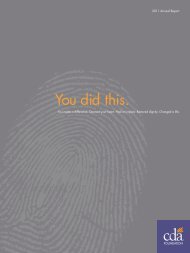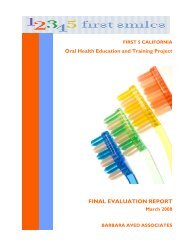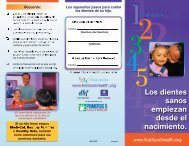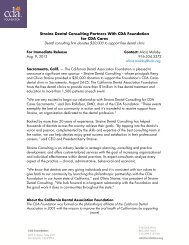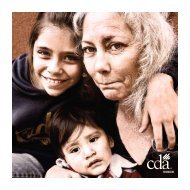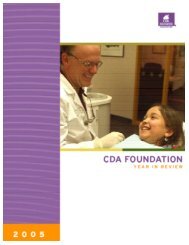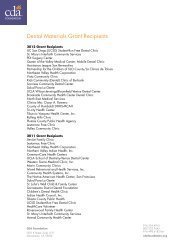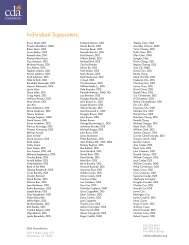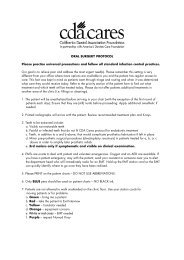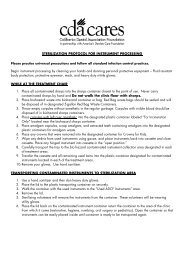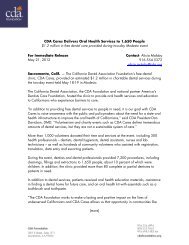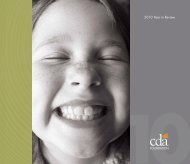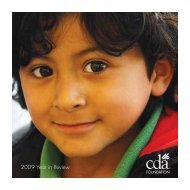DENTAL TRIAGE PROTOCOL - CDA Foundation
DENTAL TRIAGE PROTOCOL - CDA Foundation
DENTAL TRIAGE PROTOCOL - CDA Foundation
You also want an ePaper? Increase the reach of your titles
YUMPU automatically turns print PDFs into web optimized ePapers that Google loves.
<strong>DENTAL</strong> <strong>TRIAGE</strong> <strong>PROTOCOL</strong><br />
Our goal is to relieve pain and address the most urgent need(s). Please remember, this setting is very<br />
different from your office where more options are available to you and the patient has regular access to<br />
care.<br />
Please practice universal precautions and follow all standard infection control practices.<br />
1. Only BLUE pens should be used on patient charts – NO BLACK INK. Please PRINT all information<br />
and do not use abbreviations, they may not be understood by some of the volunteers.<br />
2. All patients go through Medical Triage. If blood pressure and glucose readings were not<br />
acceptable upon first readings, the patient is re-tested. If they test at acceptable levels, they move<br />
onto Dental Triage. If a patient tests above the upper limits listed below, the Medical Triage Lead<br />
consults with the Dental Triage Lead to make a final determination about the patient receiving<br />
dental treatment. The patient either moves onto Dental Triage or is advised to seek medical<br />
attention and is escorted to the Exit Interview (unless immediate medical attention is needed and<br />
then EMT’s are called).<br />
Blood pressure cutoff: 160/100<br />
Blood sugar cutoff: 150<br />
3. Patients are only offered one dental service (i.e. treatment in one quadrant; cleaning or fillings or<br />
extractions) unless the capacity of the clinic allows for more. Let patients know it is unlikely that all<br />
of their dental needs will be met but their immediate needs will be addressed.<br />
4. Dentists doing the initial screening should identify the areas of concern, not specific restorative<br />
options. Only note the top two - three priorities in the “Dental Screening” box. Do not list all teeth<br />
that need treatment.<br />
5. If the patient needs pre-medication antibiotics, indicate it on the form. When screening is complete,<br />
have an escort take the form and patient to the Routing table. The Routing table will send a runner<br />
to the medication area to retrieve the pre-meds. Patient will then go to X-ray or to a specific area of<br />
the clinic for treatment.<br />
6. Print the screening doctor’s name in the screening notes box.<br />
7. Route patients needing X-rays to Radiology unless exempted according to radiology protocol. Send<br />
patients who don’t need X-rays to Routing. Children should be sent to the Pediatrics area for<br />
medical and dental triage and X-rays.
8. Dentists working in X-ray triage should chart the exam by indicating the work that is recommended<br />
to be done in the priority treatment sections on the patient form. Discuss the recommended<br />
treatment with the patient and answer any questions. If a patient does not wish to have a certain<br />
recommended treatment done, indicate “patient does not want” by the recommended treatment.<br />
9. Circle the tooth numbers within the priority that need attention first. Depending on the number of<br />
patients, treatment will initially be limited to one quadrant so identify teeth accordingly.<br />
10. Check with the Routing Lead before recommending endo or lab services to ensure capacity has not<br />
been reached for the day. Endo is only done on anterior teeth. Stay plates are only to replace up<br />
to 6 anterior teeth – no bicuspids or molars.<br />
11. 3rd molars will only be extracted if symptomatic and visible on clinical<br />
examination.<br />
12. Lab services are limited to anterior stay plates, denture and partial repair and Larell dentures.<br />
13. If a treatment partial is recommended, you do not need to list X-ray, lab and oral surgery as<br />
individual priorities; they should all be listed as one priority.<br />
14. Print the X-ray triage doctor’s name on the form.<br />
15. If you receive a sharps injury (instrument or needle stick) or incur any other personal injury, notify<br />
the department Lead immediately. He/she will follow the sharps or accident protocol.<br />
16. EMTs are onsite to deal with patient and volunteer emergencies. If you have a patient emergency,<br />
stay with the patient, send your assistant or someone near you to alert the Department Lead who<br />
will immediately radio for an EMT. Hold up the EMT station card so the EMT can quickly identify<br />
where to go once they have been radioed.<br />
17. Please stagger your breaks. Be sure to let the department head know how long you will be gone,<br />
depending on the time someone else may use the chair while you are gone so patient flow isn’t<br />
disrupted.




